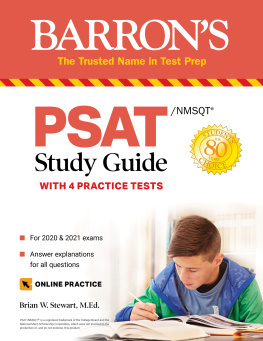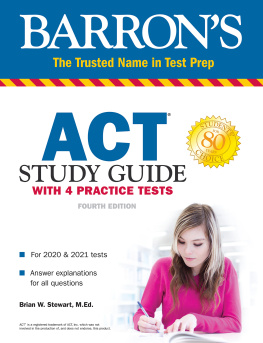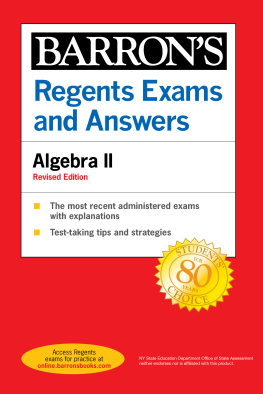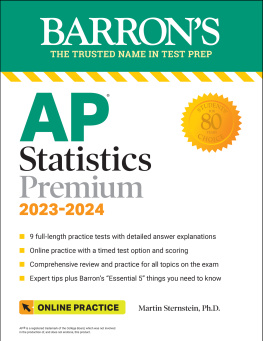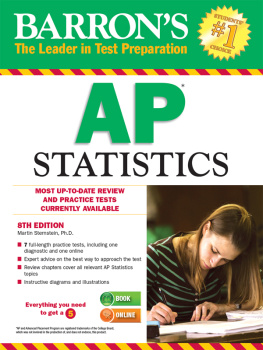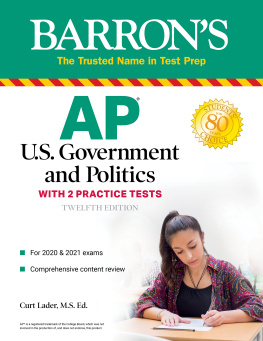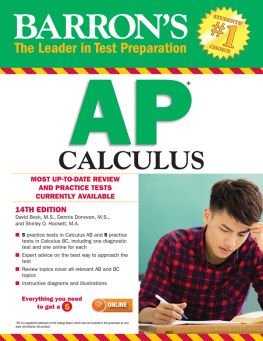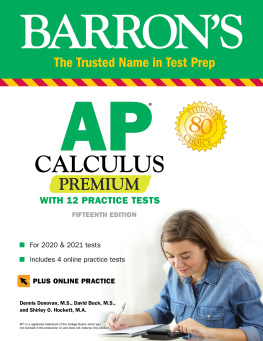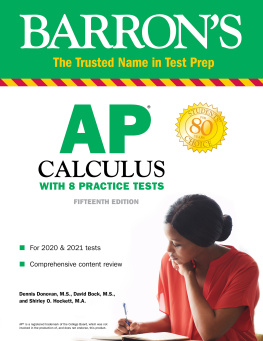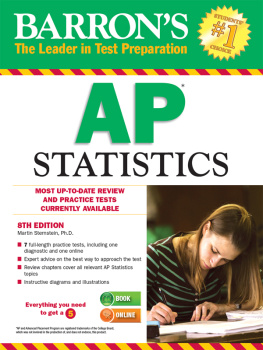Barrons - AP Statistics with 6 Practice Tests
Here you can read online Barrons - AP Statistics with 6 Practice Tests full text of the book (entire story) in english for free. Download pdf and epub, get meaning, cover and reviews about this ebook. year: 2020, genre: Children. Description of the work, (preface) as well as reviews are available. Best literature library LitArk.com created for fans of good reading and offers a wide selection of genres:
Romance novel
Science fiction
Adventure
Detective
Science
History
Home and family
Prose
Art
Politics
Computer
Non-fiction
Religion
Business
Children
Humor
Choose a favorite category and find really read worthwhile books. Enjoy immersion in the world of imagination, feel the emotions of the characters or learn something new for yourself, make an fascinating discovery.
AP Statistics with 6 Practice Tests: summary, description and annotation
We offer to read an annotation, description, summary or preface (depends on what the author of the book "AP Statistics with 6 Practice Tests" wrote himself). If you haven't found the necessary information about the book — write in the comments, we will try to find it.
AP Statistics with 6 Practice Tests — read online for free the complete book (whole text) full work
Below is the text of the book, divided by pages. System saving the place of the last page read, allows you to conveniently read the book "AP Statistics with 6 Practice Tests" online for free, without having to search again every time where you left off. Put a bookmark, and you can go to the page where you finished reading at any time.
Font size:
Interval:
Bookmark:
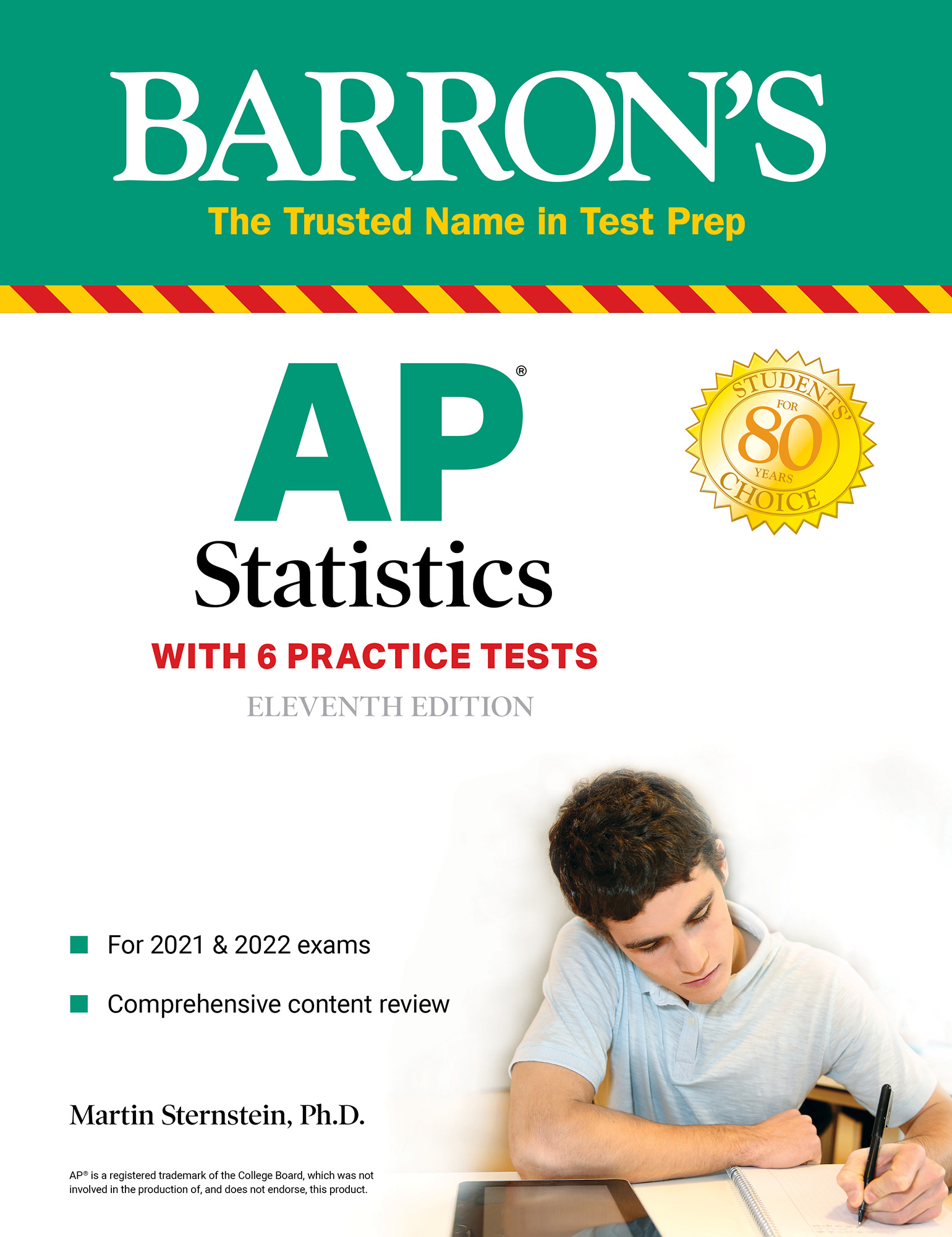
Martin Sternstein, Ph.D.
Professor Emeritus
Department of Mathematics
Ithaca College
Ithaca, New York
AP and Advanced Placement Program are registered trademarks of the College Board, which was not involved in the production of, and does not endorse, this product.
Dr. Martin Sternstein, Professor Emeritus at Ithaca College, was honored by Princeton Review as one of the nations 300 Best College Professors. He is a long-time College Board consultant and has been a Reader and Table Leader for the AP Statistics exam for many years. He has strong interests in national educational and social issues concerning equal access to math education for all. For two years, he was a Fulbright Professor in Liberia, West Africa, after which he developed a popular Math in Africa course, and he is the only mathematician to have given a presentation at the annual Conference on African Linguistics. He also taught the first U.S. course for college credit in chess theory.
Thanks to Annie Bernberg, editor at Kaplan, for her guidance. Thanks to my brother, Allan, my sister-in-law, Marilyn, my sons, Jonathan and Jeremy, my daughters-in-law, Asia and Cheryl, and my grandchildren, Jaiden, Jordan, Josiah, Luna, and Jayme, for their heartfelt love and support. Most of all, thanks are due to my wife, Faith, whose love, warm encouragement, and always calm and optimistic perspective on life provide a home environment in which deadlines can be met and goals easily achieved. My sincere appreciation goes to the participants who have attended my AP Statistics workshops for teaching me just as much as I have taught them, and special thanks for their many useful suggestions are due to the following exceptional teachers:
| David Bock | Ithaca High School, Ithaca, NY (retired) |
| Paul Buckley | Gonzaga College High School, Washington, DC |
| Dawn Dentato | Somers High School, Lincolndale, NY |
| Jared Derksen | Rancho Cucamonga High School, Rancho Cucamonga, CA |
| Kristina Gazdik | Bishop Kelly High School, Boise, ID |
| Sarah Johnson | Grand Blanc High School, Grand Blanc, MI |
| Lee Kucera | University of California, Irvine, CA |
| Brendan Murphy | John Bapst Memorial High School, Bangor, ME |
| Kenn Pendleton | Montgomery College, Germantown, MD |
| Adam Riazi | Cabell Midland High School, Ona, WV |
| Roy St. Laurent | Northern Arizona University, Flagstaff, AZ |
| Daren Starnes | The Lawrenceville School, Lawrenceville, NJ |
| Josh Tabor | Canyon del Oro High School, Oro Valley, Arizona |
| Jane Viau | Frederick Douglass Academy, New York, NY |
| Dawn White | Silver Lake Regional High School, Kingston, MA |
Ithaca College | Martin Sternstein |
| Spring 2020 |
Copyright 2020, 2019, 2017, 2015, 2013, 2012, 2010, 2007 by Kaplan, Inc., d/b/a Barrons Educational Series
Copyright 2004, 2000, 1998 by Kaplan, Inc., d/b/a Barrons Educational Series, under the title How to Prepare for the AP Advanced Placement Exam in Statistics.
All rights reserved under International and Pan-American Copyright Conventions. By payment of the required fees, you have been granted the non-exclusive, non-transferable right to access and read the text of this eBook on screen. No part of this text may be reproduced, transmitted, downloaded, decompiled, reverse engineered, or stored in or introduced into any information storage and retrieval system, in any form or by any means, whether electronic or mechanical, now known or hereinafter invented, without the express written permission of the publisher.
Published by Kaplan, Inc.,
d/b/a Barrons Educational Series
750 Third Avenue
New York, NY 10017
www.barronseduc.com
ISBN: 978-1-5062-6355-7
10 9 8 7 6 5 4 3 2 1
As you review the content in this book and work toward earning that on your AP STATISTICS exam, here are five things that you MUST know:
- Graders want to give you credithelp them! Make them understand what you are doing, why you are doing it, and how you are doing it. Dont make the reader guess at what you are doing.
- Communication is just as important as statistical knowledge!
- Be sure you understand exactly what you are being asked to do or find or explain and approach each problem systematically.
- Some problems look scary on first reading but are not overly difficult and are surprisingly straightforward. Questions that take you beyond the scope of the AP curriculum will be phrased in ways that you should be able to answer them based on what you have learned in your AP Statistics class.
- Naked or bald answers will receive little or no credit. You must show where answers come from.
- On the other hand, dont give more than one solution to the same problemyou will receive credit only for the weaker one.
- Random sampling and random assignment are different ideas.
- Random sampling is the use of chance in selecting a sample from a population and is critical in being able to generalize from a sample to a population.
- A simple random sample (SRS) is when every possible sample of a given size has the same chance of being selected.
- A stratified random sample is when the population is divided into homogeneous units called strata, and random samples are chosen from each strata.
- A cluster sample is when the population is divided into heterogeneous units called clusters, and a random sample of the clusters is chosen.
- A systematic sample is when a random starting point is followed by choosing every kth member of a list.
- Random assignment in experiments is when subjects are randomly assigned to treatments and is critical in minimizing the effect of possible confounding variables.
- This randomization evens out effects over which you have no control and allows for a valid comparison of treatments.
- Randomized block design refers to when the randomization occurs only within groups of similar experimental units called blocks.
- Random sampling is the use of chance in selecting a sample from a population and is critical in being able to generalize from a sample to a population.
- Distributions describe variability, and variability is the most fundamental concept in statistics. Understand the difference between:
- population distribution (variability in an entire population),
- sample distribution (variability within a particular sample), and
- sampling distribution (variability between samples).
- The larger the sample size, the more the sample distribution looks like the population distribution.
- Central Limit Theorem: the larger the sample size, the more the sampling distribution (probability distribution of the sample means) looks like a normal distribution.
- Choosing the correct procedure and performing proper checks are critical.
- Categorical variables lead to proportions or chi-square procedures, while quantitative variables lead to means or linear regression.
- Decide whether there is a single population of interest or two populations being compared.
- Categorical variables lead to proportions or chi-square procedures, while quantitative variables lead to means or linear regression.
Font size:
Interval:
Bookmark:
Similar books «AP Statistics with 6 Practice Tests»
Look at similar books to AP Statistics with 6 Practice Tests. We have selected literature similar in name and meaning in the hope of providing readers with more options to find new, interesting, not yet read works.
Discussion, reviews of the book AP Statistics with 6 Practice Tests and just readers' own opinions. Leave your comments, write what you think about the work, its meaning or the main characters. Specify what exactly you liked and what you didn't like, and why you think so.


